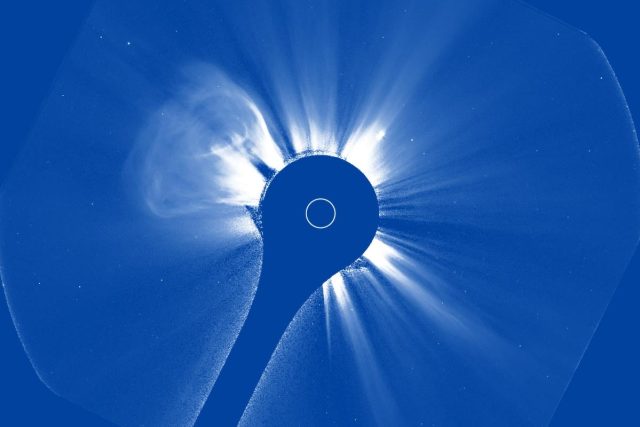
Włączono kompaktowy koronograf NRL[{” attribute=”” tabindex=”0″ role=”link”>NOAA’s GOES-19 spacecraft has started capturing crucial images of the Sun’s atmosphere and solar phenomena, aiding in the prediction of space weather effects on Earth.
The U.S. Naval Research Laboratory’s (NRL) Compact Coronagraph (CCOR) has successfully captured its first images of coronal mass ejections (CMEs).
The CCOR is a small space telescope specifically designed to observe the Sun’s outer atmosphere. On September 19, its aperture door was opened for the first time since the instrument was launched aboard the National Oceanic and Atmospheric Administration’s (NOAA) GOES-19 spacecraft on June 25 from NASA’s Kennedy Space Center.

Observing the Sun’s Outer Atmosphere
When the sunlight illuminated the inside of the instrument, a central cylindrical device called an occulter blocked the Sun’s disk, creating an artificial eclipse—similar to how the Moon blocks the Sun during a natural eclipse. This allows the CCOR to focus on the solar corona, the Sun’s outer atmosphere, explained Arnaud Thernisien, a research physicist at NRL’s Advanced Sensor Technology Section in the Space Science Division.
On October 3, the CCOR saw a perfect illustration of the Sun’s activity called a halo. Halos appear on coronagraph images as near-circular shapes, approximately concentric with the Sun’s center. The observed halo CME resulted in some effects seen on Earth a few days later including a rare glimpse of northern lights visible across the northern United States from Washington state to Maine. Northern lights, also called auroras, are the result of Earth’s magnetosphere disturbance with solar wind.

Continuous Monitoring and Future Developments
Over the next few weeks, the CCOR witnessed several CMEs including another halo on Oct. 10, resulting from an active region at the surface of the sun. “Halo CMEs are of particular interest for space weather as they are generally directed towards Earth,” Thernisien said.
“By creating an artificial eclipse, the CCOR allows scientists to study the Sun’s corona, which can produce powerful solar storms that can disrupt Earth-based technologies,” said Thernisien. “The CCOR team is thrilled to see that the instrument is performing as expected.”
Role in Space Weather Prediction
The instrument is used by NOAA’s Space Weather Prediction Center (SWPC) and DOD to detect CMEs with low latency, providing critical early warnings of solar storms. CMEs can have severe consequences, including damage to satellites, disruptions to radio communications, and power grid failures.
To pierwsze wideo CCOR-1 pokazuje wyraźnie zdefiniowany CME wyłaniający się ze wschodniej krawędzi (lewa strona) Słońca około godziny 10:00, z czasem uniwersalnym (UT) pokazanym w lewym dolnym rogu. Słońce olśniewa także swoimi małymi i dużymi serpentynami, jasnymi strukturami promieniowymi, wzdłuż których biegnie słońce osocze przemieszcza się stale na zewnątrz. Eksplozje CME zaginają i czasami zakłócają płynącą plazmę, brzęczącą obok niej z prędkością od setek do tysięcy mil na sekundę. Źródło: NOAA/NASA
Ekspansja i cele długoterminowe
CCOR NRL to pierwszy działający koronograf w kraju. Operacyjny oznacza, że instrument jest przystosowany do prowadzenia obserwacji korony z niskim opóźnieniem i charakteryzuje się pewną odpornością na skutki pogody kosmicznej wywołane promieniowaniem.
CCOR to dopiero początek serii operacyjnych koronografów, które NRL opracowuje dla NOAA. Wystrzelenie drugiego instrumentu, CCOR-2, zaplanowano na połowę 2025 roku. Dodatkowo NRL pracuje nad kompaktowym koronografem dla Europejska Agencja Kosmicznamisji Vigil, której wystrzelenie zaplanowano na rok 2031.
„Zespół NRL we współpracy z zespołem NOAA-NASA GOES będzie kontynuował testowanie możliwości CCOR-1 w przestrzeni kosmicznej do końca stycznia 2025 r., kiedy zostanie on przekazany NOAA” – powiedział Thernisien. „NRL pragnie podziękować Biuru Obserwacji Pogody Kosmicznej NOAA-NASA oraz Biuru Badań Marynarki Wojennej za ich wsparcie.”




